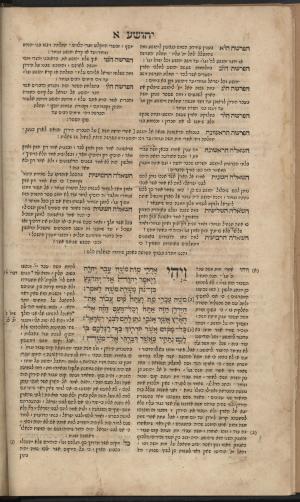Obj. ID: 35694
Jewish printed books Perush al Nevi’im Rishonim by Yitzhak ben Yehudah Abarbanel, Leipzig, 1686

This text was prepared by William Gross:
The first Hebrew book pubilshed in Leipzig. Title page with elegant gate motif topped by illustration of the Tree of Life, symbolizing the Torah.
Don Isaac ben Judah Abrabanel’s classic commentary on Nevi’im Rishonim. First published in Pesaro, 1511, this second or third edition was published by the Christian printer, Mauritius George Weidmann. A Hamburg edition was published in the same year, also by a non-Jew, Thomas Rose. It is likely that neither printer was aware of the other’s intentions.
The Lepizig edition bears title pages in both Hebrew and Latin. The former states that this commentary “was printed once a very long time ago and has practically perished from the earth. Therefore, due to the value of this commentary and its great rarity, we have made a considerable effort to bring it to press anew…”
The work’s editor, F.A. Christiani was an apostate who, born Baruch Moses of Prossnitz, abandoned Judaism in 1674. He was responsible for the publication of this title and several other works either by Jews or works related to Judaism from a Christian perspective. After serving as the chair of Semitic Studies at the University of Leipzig for twenty years, he retired to Prossnitz and reputedly returned to Judaism.
Title page with elegant gate motif. The gate illustration had been used with almost infinite variations over many years by both Jewish and non-Jewish publishers since around 1500. This version is based on a type used in Amsterdam some decades earlier by publishers of Hebrew books. Different versions of it are found on books from the presses of Jewish printers in many cities in Europe. In this version, at the top, is an illustration of a tree, representing the Tree of Life, which is, itself, a symbol representing the Torah.
Don Isaac ben Judah Abarbanel (1437 – 1508) began this work when still in Lisbon. His unfinished manuscript was lost, however, when he was forced to flee Portugal in 1483. Miraculously, he found a copy of the manuscript ten years later while in Corfu, whereupon he dedicated himself to completing the work. It was finished in 1496 in Monopoli (Apulia).
The title page shows an architectural frame with standing representations of the mythological Minerva and Mars. This border was first employed by Francesco Minizio Calvo in Rome in 1523 and as late as 1540 in Milan. This is its earliest appearance in a Hebrew book. It was often reused and copied, appearing on the title pages of books printed as far apart as Salonika and Cracow.
Rabbi Don Isaac ben Judah Abravanel (Abarbanel) was a Portuguese rabbi, scholar, Bible commentator, philosopher, and statesman. Born in Lisbon, Portugal, he studied Talmud, philosophy, and secular studies. He was one of the first Jewish scholars to be influenced by Renaissance writers, and was a major thinker and prolific Jewish scholar. In three treatises, he predicted that the Messiah would come in the near future.
Abarbanel is best-known, however, for his brilliance as a financier and as a diplomat. His political career started in Portugal, where he served as the personal agent of King Alfonso V. As treasurer, he took the unusual position of frequently using his own monies as well as the state's. In 1471, when 250 Jews were held for ransom by Alfonso, Abarbanel helped raise the required monies. He was tremendously influential among the wealthy Christians in Portugal and remained a powerful figure in the Portuguese court. However, with the accession of John II in 1481, anti-Jewish sentiments in the church and the legislature which were suppressed during the reign of his father found a sounding board. R. Abarbanel was almost executed, but managed to sneak over the border into the Spanish town of Segura de la Orden in 1483. The following year King Ferdinand invited him to be the collector of royal revenues, even though it was illegal for a Jew to hold such a high position and the Spanish Inquisition was in full swing. After having provided Ferdinand and Isabella with the monies needed to take Grenada, Abarbanel was shocked to learn that they had decided to expel all Jews from Spain. He (and maybe Abraham Senior) offered a huge bribe to rescind the edict, but they failed.
In May, 1492, Abarbanel found himself under tremendous pressure to convert and retain his status in the Spanish court. He refused, managed to smuggle his young son out of the country, and headed for Naples. He was permitted to take a thousand gold ducats with him, and was also able to get bills of exchange for much of his fortune, softening the financial blow of his departure.
In Naples, he planned to concentrate on writing his commentary to the Bible. However, he was again employed by the king to be the prime tax collector. He and the king had to flee from the French. Abarbanel lost his library. He finally settled in Venice in 1503.




